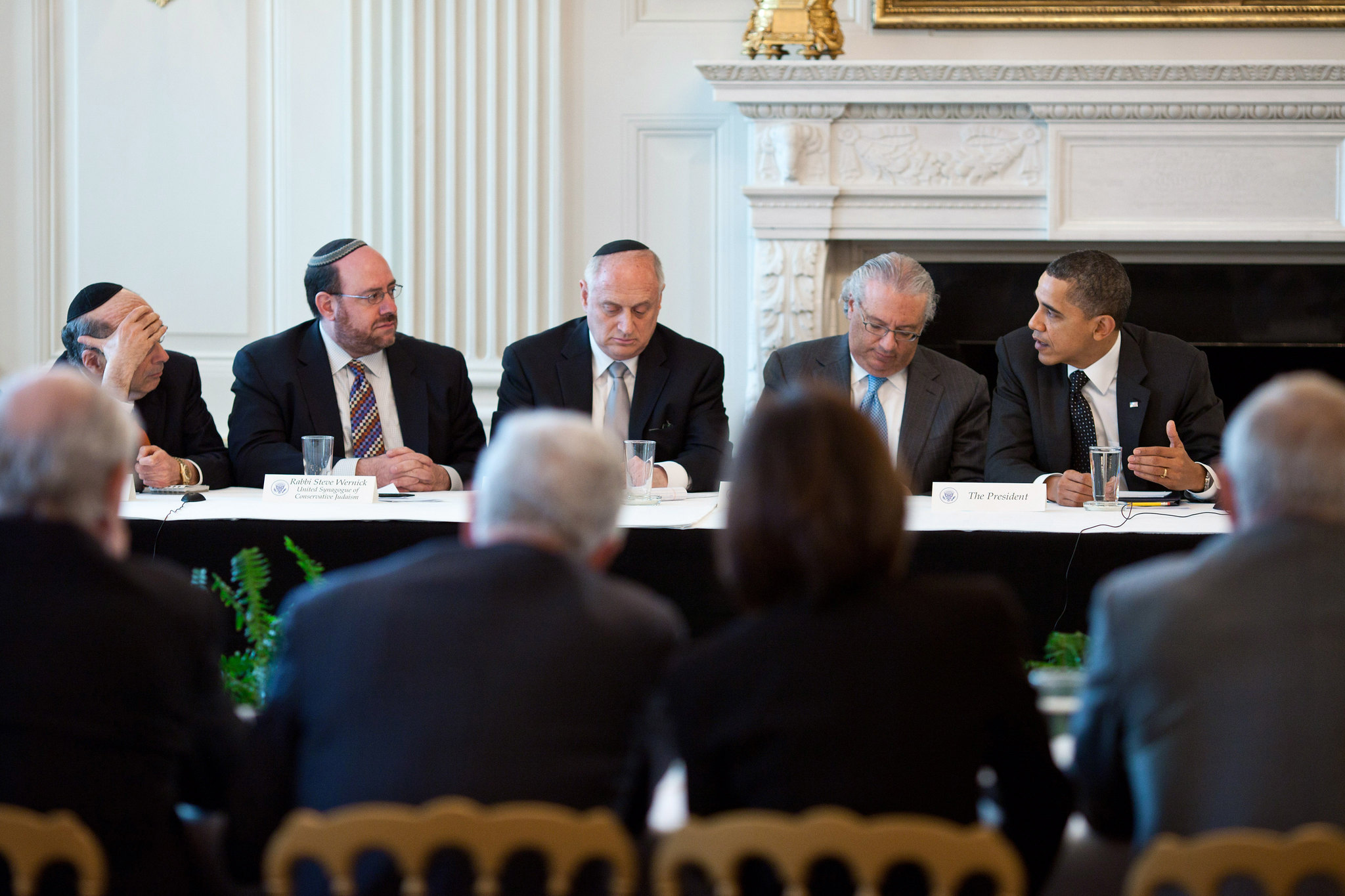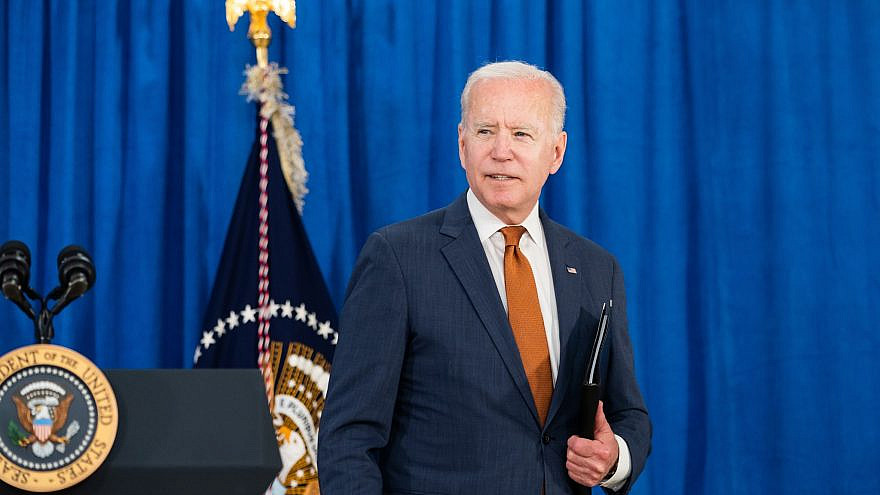For months, Jewish organizations in the United States have been lobbying to appoint a White House Jewish liaison. And after numerous meetings between Jewish organizational leaders and administration officials when violence erupted last month between Israel and Hamas in the Gaza Strip—followed by a wave of anti-Semitic attacks—that role and that of the State Department Special Envoy for Monitoring and Combating anti-Semitism have yet to be filled.
Most who spoke to JNS said that it was a matter of days or weeks before appointments are made, although they declined to speculate on particular nominees.
Eric Fusfield, director of legislative affairs for B’nai B’rith International, said in addition to the Mideast conflict in May, concerns include the Iranian nuclear threat and ongoing discussions towards U.S. re-entry into a deal, Israel’s new leadership and, just this week, new Iranian leadership in the form of President-elect Ebrahim Raisi. American Jewish organizations want to make the White House aware of its opinions to make sure the U.S.-Israel relationship remains strong, as well as address how Jews are being treated in the United States.
The liaison’s position, he said, serves as a focal point for Jewish organizations to contact the White House to make sure their message is heard by those who have the power to augment change.
While he said that every administration has a settling-in period where it works to nominate individuals for key positions, the six-month window is approaching, and the Jewish community is experiencing urgent needs.
“We need a mailing address for voicing our concerns, and the liaison fills that need for us,” he said. “We’re feeling a great deal of anxiety about certain issues right now, and having a conduit in the administration would help further communication and help us get our point across.”
‘It’s a shliach to the community’
The job of White House Jewish liaison first became official in the Reagan administration and each president since, except for former President Donald Trump, had multiple people who filled the role during their administration’s tenure.
Over the years, the job was handled by a variety of administration employees, with the position sometimes becoming the responsibility of a junior staffer or someone more senior in the administration with other responsibilities. Often, these people were taken from other departments in the administration.
The Trump administration did not have an official liaison. The unofficial point-person for many organizations was Paul Teller, who served as special assistant to the president for legislative affairs, and later, as the director of strategic affairs for Vice President Mike Pence.
Democratic strategist Steve Rabinowitz said the position accomplishes two things: “It catches incoming, and it’s a shliach to the community.”
The job brings the president’s agenda to the Jewish community, as well as information about programs and events, he explained, and “the things that people need—whether it’s little stuff, like ‘we need a letter from the president for our program or a video for our convention’ or a speaker for our event. Or they want an invitation for something or a tour. Everybody wants something, and so it all goes through this poor schmuck who has the title of White House Jewish liaison. This person tries to take care of everybody.”
Matt Nosanchuk, who served as a liaison in addition to his other duties from 2013 to 2016 under former President Barack Obama, said others often joked that he had the hardest job in Washington.
The Jewish community has “organizations of organizations, is what I’ve often said. Because we have many organizations and a community with a very long history of engagement on a wide range of issues,” said Nosanchuk. “What appealed to me—what the liaison has the opportunity to do because the Jewish community is engaged with and cares about so many issues, both domestic and international—was the opportunity to engage on those issues. That was a really great vantage point from which to work at the White House.”

This and other similar roles in the White House, he added, served as conduits from the administration to various constituencies.
The White House has liaison positions for other demographics as well, including the Hispanic, African-American and business communities, among dozens of other specified titles.
Nosanchuk said he juggled other duties in the White House while serving in the role of liaison. He had an international portfolio that included engagement with other Diaspora communities and was a director of outreach for the National Security Council.
“I think you have to recognize that the White House is a leanly staffed place. I mean, there aren’t very many billets or slots; people work incredibly hard and wear a number of hats, and everyone that works in the White House relies extensively on interns,” he explained.
“What you do,” he emphasized, “is leverage time and people power effectively to get a lot done.”
‘They did not have a full transition’
Jarrod Bernstein, who served as liaison from October 2011 to February 2013, said that he believes the delay in naming of someone now stems from the administration’s initial focus on battling the pandemic and filling other key slots, which was hampered by the lack of a smooth transition from the Trump administration.
“They did not have a full transition because President Trump, for quite some time, refused to acknowledge President Biden’s victory, refused to begin the transition process, and that has a trickle-down effect on lots of things,” he said.
Another factor, he noted, could be the already longstanding relationship between known senior administration officials such as Secretary of State Antony Blinken and others within the Jewish community, which has moved finding an official liaison further down on the administration’s priority list.
Still, while the Jewish community has been able to secure several virtual meetings with the administration, errors like the recently reported leaving out of key Jewish organizations for a virtual meeting with Blinken has put more pressure on the administration to act.

Facilitating these meetings between Jewish organizations and administration officials is an important part of the job.
“Somebody once told me that we are 2 percent of the population, but we are 20 percent of the meetings,” said Bernstein. “Meaning, we’re a very organized community, we have a lot of amazing talent, and we’re very involved in the civic process, which is a good thing.”
But attendance at meetings changes with different presidential administrations, according to Tevi Troy, who served as the Jewish liaison from 2003 to 2004 in the Bush administration.
“I think every administration makes choices about who they deal with, who they have more prominent meetings with,” he said. “I’ll give one famous example in a Republican administration: You always have the Republican Jewish Coalition at the White House, but you don’t have them in a Democratic administration. Where similarly, the Democrats will always have the NJDC—the National Jewish Democratic Council—and the Republicans wouldn’t have them.”
Other times, Troy said, the administration would bypass these groups altogether to interact with what he called more “organic” community leaders, by which he meant local rabbis and communal heads outside of the Washington representatives with their well-honed sets of talking points.
It was always important to have a clear reason, especially before the advent of virtual meetings where space was limited, of which groups to include in what meeting and why.
‘It’s always good to have a point person’
What the White House may also be contemplating in its effort to pick a liaison is how highly ranked it wants the official to be to best fit the role. There is a choice of whether to make it a full-time position in the White House Office of Public Engagement, which would mean a lower-level job such as that of an associate director—a non-commissioned position.
Otherwise, it could be given to a higher-ranking official with a commissioned position, who would have to fill more roles.
At the time Troy served as a liaison, he was also special assistant to the president and fulfilled the liaison’s role in addition to his other duties.
Troy, who later became U.S. Deputy Secretary of Health and Human Services, said that he preferred having a more senior official do the job. “I’m biased since I did it that way,” he said. “I think the Jewish community likes, not surprisingly, to talk to a higher-ranking person that can make a difference.”
Malcolm Hoenlein, vice president of the Conference of Presidents of Major American Jewish Organizations, said that he would rather have someone of lower rank who could be more accessible.
“It’s always good to have a point person that people know because you can’t [always] turn to higher-level people who have all sorts of other responsibilities to do the nitty-gritty work or things that come up,” said Hoenlein.
But for Hoenlein, the total structure of how the position is handled is important, which is what he believes is partially holding up the selection process.
“Many administrations didn’t appoint people until several months into the administration. There are still a lot of embassies that are open. … And the Jewish liaison, I think, has to be part of a structure of what their outreach program will be.”
Each administration has its own style of Jewish liaison, he said, but not all positions have the same pressure on the administration to appoint someone, like the Jewish liaison.
“Hopefully, there will be somebody who will be able to communicate not just to the community but from the community,” said Hoenlein, adding that the more confidence people have in whoever is assigned to the role, the better.

























